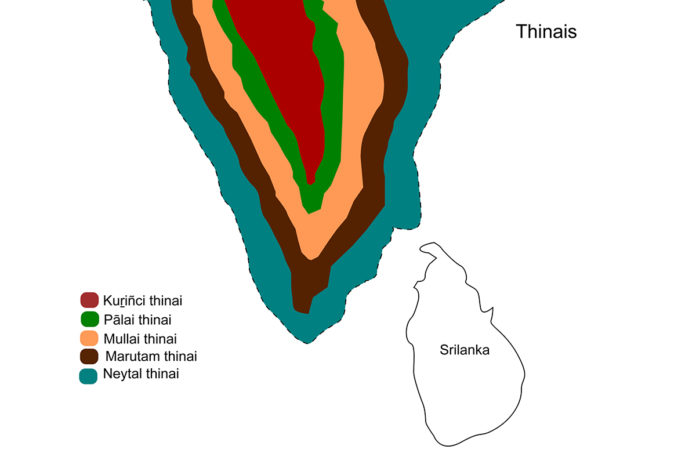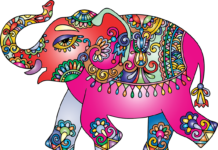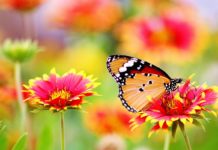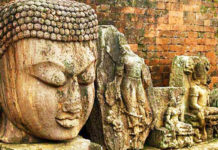Poetry is a literary art that reflects human life in an aesthetic way. It deals with many concepts like love, war, truth, happiness, frustrations, hopes, friendship, enmity and beliefs. If life is considered as a journey poetry which is a form of literature plays a vital role of a vehicle in expressing the feelings of mankind in various facets in their lifespan. The traditional treasury of Tamil literature, the sangam poems reflect on the concept of love and deals with various aspects of love like the consummation of love, waiting for lover’s return after a long separation , small quarrels among them ,etc. The poems deploy nature and its surrounding landscape as a framework to express human love. Landscape assumes the status of a strong raw material that is moulded to project the perceptions of man on the inextricable relationship that exists between the lovers both at premarital stage and after marriage. Daniel and Cosgrove define it as an outward expression of human perception, “a landscape is a cultural image, a pictorial way of representing, structuring or symbolizing surroundings” (Daniel & Cosgrove,1988). The sangam literature is classified as the literature of “aham” and that of “puram’. ”Aham” deals with topics on personal or human aspects, such as love and sexual relationships, and are dealt with in a metaphorical and abstract manner. The ‘outer field’ topics discuss all other aspects of human experience such as heroism, war, valour, ethics, benevolence, philanthropy, social life, and customs.
The landscape is divided into different categories as per the geographical location .The flora, fauna, the climatic conditions, animals the inhabitants and their culture in association with the location are correlated with the mindset of the lovers in the poem. This device is called as thinai and each episode relating to a particular love event is codified. The thinais are five namely Kurinji, Mullai, Marutham, Neithal and Palai .The details of these thinais are dealt with as follows:
Poetic Attributes of the Landscapes:
Kurinji: This thinai speculates on the union of lovers. The landscape is a mountainous region with a special flower named kurinji that blossoms once in twelve years. Monkeys, elephants and bull are the animals of the location and are filled with bamboos, jack fruit trees and ‘venkai’ trees. The occupants are tribal people who hunt and gather honey. The place is cool with water in abundance and represents midnight of a day.
Mullai: It is a forest region representing evening time when the lady love is patiently waiting for her lover. The specific flower is jasmine and the animal of the area is deer. The region is filled with’ konrai’ trees and due to the presence of rivers the soil is red and fertile paving way for rich farming by the farmers there.
Marutham: Here the event narrated is the fight and the mental conflict that takes place between the lovers at early morning time before sunrise. It is agricultural pasture lands with mango trees and ponds brimming with water. The fresh water fish and water buffaloes are in abundance here. Agriculture is the main occupation of the people residing here.
Neithal: This thinai describes the pangs of separation of the lovers and the background location is seashore, full of sandy soil. The place is filled with ‘punnai’ trees, crocodiles and sharks. The inhabitants are the fisher folks who go deep into the sea to catch fish.
Palai: Dangerous journeys undertaken by the hero as well as both the lovers through desert areas and the hindrances they face are vividly described here. It is a parched wasteland or desert and the time associated is noon in the scorching summer .Elephants, tiger or wolf wander there and nothing but cactus can be seen in this desert area. The bandits steal things from the travelers for their food and other needs.
The traits of the above five kinds of geographical locations are intertwined with the lover’s emotions. The sangam poems not only describe the love deal but goes beyond the personal details to portray the specific culture of the occupants and thereby the literary works attain universality with the deployment of such a device .The poems in other languages like English also reiterate the fact that the natural surrounding and the objects of nature correlates human life in all its phases. Poetry is nothing but the “overflow of powerful feelings recollected in tranquility” (Wordsworth,1962,p.165).
When the feelings are channelized into different compartments the location acts as a scaffolding, triggering deep contemplation, enhancing quick and easy comprehension due to the imageries that emerge in the embedded framework. A poem of Philip Larkin can empirically prove that this is a universal technique adopted by poets of any language. The poem “Wedding Wind“ by Larkin expresses the joy and excitement experienced by a young lady on the brink of her new life. The wind symbolizes renewal and fresh energy. The newly wedded damsel realizes her multiple new responsibilities’ as wife, lover ,life partner sharing the farm works of her husband. The inner experience and the inner growth from a simple maid to a responsible woman is traced here utilizing symbolic representation. The first night and the first day of her wedded life are special to her. Even in the absence of her husband on the very first day of her married life she could feel the impact of their union both inward and outward In kurinji thinai of sangam songs similar concept of the impact of the union and its lifelong effect is projected (Kuruntokai,Vol.1,p.113).
She recalls seeing her face in the “twisted candlestick” but yet she admits to “seeing nothing”. “Now in the day”, when she experiences the wind as she feeds the chickens that she fully realizes its meaning as a symbol for her own new energy and delight. Notice that there is no honeymoon. She must look to her chores as must her husband;“He has gone to look to the floods, and I carry a chipped pail to the chicken run,” This might be seen as tedium but the change she undergoes is an inward, spiritual one. It leads her to ask those profound questions (they are really statements) which end the poem.. “Can it be borne, this bodying forth by wind of joy my actions turn on, like a thread carrying beads?”
The thrill of her excitement is so intense that only the wind is big enough to embody it, “bodying forth”. The meaning of her life is clear to her now. Even her simple actions like feeding chickens feel as if they are part of a greater unified whole, “like a thread carrying beads.” The sexual joy, the romance, her ownership of the farm, the very newness of her situation makes her so giddy, so thrilled that she feels she will never be able to calm down again so that she may sleep. The windy morning symbolizes all that is new and energetic in her life. In Sangam literature four types of wind are mentioned .The wind from the southern side is known as ‘tendral’ and it is a gentle breeze; that which comes from northern side is termed as ‘vaadai’ and is cold.;from the west comes the ‘kootai’ and ’kondal’ is from the east. Each one has its own features but in general wind stands for force and energy.
The brimming lake symbolizes new and satisfactory life and the cattle drinking water to quench the thirst is an expression of gratitude for the life gained. This poem tells how the lakes and cattle bring out the sense of satisfaction and self realization of the newly wedded girl. Keats also talks of the everlasting hunger of the male lover who tries chase and embrace her in his Ode on a Grecian Urn. Similarly the Aham songs of the sangam literature are potential area of research and analysis and the paper tries to explain certain poems from Kuruntokai and Narrinai. Kalitokai also deals with all the five landscapes very deftly projecting the lovers’ intimacy and strong love knot.
Imageries and culture in Kurinji Thinai:
In Kuruntokai (Kuruntokai,2007,p109) song no.40 deals with the intimacy of love between the lovers. Though they do not have any blood relation their love knot is strong and they can never be separated as the mixture of red earth and the rain water (Agesthilingom,2002,p.46-47). The consistency and the amalgamation is so perfect in this mixture, the dry parched earth with red soil on the surface and the rain water. If analyzed deeply the growth of relationship is visible-getting deepened from the older generation to the younger. Still moving further down the mentioning of the Kurinji flower which blooms once in twelve years is symbolic in indicating the blossom of the feminine sense ready to get united with the mate physically and spiritually. The three dimensional semantic interpretation is made possible with the imagery related to the particular landscape. The poem goes as follows:
What could my mother be
To yours? What kin is my father
To yours anyway? And how
Did you and I meet ever?
But in love our hearts are as red
Earth and pouring rain mingled
Beyond parting.
In Narrinai (Narrinai,2007,p.17)song no. 6 describes the mental happiness the lady love would attain if she comes to know of the arrival of her lover. The excitement and joy is equated with that of a deer when it gets its hunger satisfied with a share of tasty ripe fruits of the Kumizhi tree. The deep level indication is that the lady love even without the physical union experiences the pleasure of consummation like the deer deriving after having consumed the fruit. The third level of interpretation is the quality of love is like the high quality of the edible, the fruit. In song 1 the ‘talaivi’ talks high of love of her ‘talaivan’. She emphatically tells her friend that talaivan’s love is as splendid as the honey gathered by the honey bee from the cool stem of the lotus flower and hoarded in the sandal trees. Like Lord Muruga, the chief of the mountains, the sandal tree with red wood and fragrance hints at the physical charm of the male lover. Further she assures his awareness that his lover will not exist without him and therefore he will never part with her.
The example of the perennial water flow indicates the durability and constancy of the love of both. In song 5, the lady indicates the pangs of separation during early winter through her eyes to the hero. When the entire nature will be nurtured and flourishing-the vegetation rich due to rain, waterfalls overwhelming with cool water, the ‘nara’ creepers spreading on the sandal trees rejuvenating, the clouds moving towards them, this specific season reflects sexual union and pleasure and this is not the time for separation. The ambience endorses the erotic thought waves of the lady and the poem signifies the powerful association of nature with man’s mental, spiritual and physical feelings. In the kurinji thinai another significant tree mentioned is the mango tree which is the personification of Kama, the god of love and sex .A female lover is always said to have the colour of fresh sprouts of mango (mantalir in song 6),or dark blue. Similarly as mentioned earlier the ripeness of the fruits, the rich vegetation and the overflowing water flow symbolically signifies the maturity of the mind and the physical body ready to accept and taste the sexual union with a male and realize the real meaning of family life. The traits of love as expressed here are true in any part of the world (Compare Larkin’s poem mentioned earlier) and invisibly the poet moves from personal representation to impersonal and thereby his poems reach the height of universality.
Neithal Thinai:
In song 5 of Kuruntakoi (Kuruntokai,2007,Vol.1,p.19) the pangs of separation experienced by the ‘talaivi’ and her mental agony is depicted. In this context the songs vividly portray the sea shore and its surroundings- the ‘punnai’ trees that offer shades to the birds to sleep and the waves dashing against the sands on the shore, from where the talaivan originates. The message conveyed is the restless mind and sleeplessness of the lover can very well be compared to the waves which is always moving forward and receding continuously without stopping. In another song the lady love expresses her pain as her husband neglects her, going behind another lady called as ‘parathai’ equivalent to a prostitute. The environment of the water reservoir like sea, ponds etc. the drowning ‘neithal’ flower and the ponds rich with ferns- all these give deeper insight into the love relationship. The over flowing water which causes the flowers’ downward movement can be taken as a symbolic outlet of the pent up emotions of the lady who suffers within herself without letting out the secret love of her husband.
The simile employed here is the eyes of the lady and the flower. The aptness of the comparison can be felt as both are outlets of emotions ,the eyes and the drowning flower moving downwards exhibiting negative emotions. (Kuruntokai,Vol.1.p.31). The neithal thinai has an environment that is filled with water. The five materials of the cosmos earth, water, sky, wind and fire are life giving as well as damaging factors and these materials connotes both positive and negative concepts and type of water reservoirs mentioned in the songs with the particular landscape is an indication of negative connotation as the mood exhibits separation and the mental agony of the lady love due to separation. The ‘talaivan’ can be separated from his lady love in anyway, either to earn money or for having extra marital relationship with some other lady.
Palai Thinai:
This particular thinai talks of wasteland or deserts and the journeys undertaken by the lovers as they elope through the desert. Obviously they have to face many problems and overcome hurdles on their way. The forceful West wind hits the ‘vahai’ tree causing noise which is like the loud sound of the drums that accompanies the dance of ariya koothers on the ropes, across the roads. The male lovers wear anklets like, ‘kazals’ that symbolizes bravery while the lady love wears anklets on her feet. Along with such explanations the song also talks of ceremony in which the anklets will be removed before marriage, and this is specified as ‘anklet removal ceremony’. (Kuruntokai,Vol.1.2007,p.25).The journeys of the lovers through the wasteland can also be viewed as the lovers spiritual and internal journey where they need to walk hand in hand overcoming all hurdles on their family life to have a full consummation of love beyond physical union. This is very subtly mentioned in song (Narrinai,2007,p.17), where the friend requests the hero that he shouldn’t betray her friends even in the old age as she has eloped with him based on the trust on his sincere, true love. The journey as per the Tamil philosophy is a divine and sacred pilgrimage where the lovers are replicas of divine beings and are expected to lead a truthful lead a life with unbound love and unity. The path is not as cool as kurinji’s mountainous region or as fertile as the pasture land of mullai and marutham. The time of the landscape is noon with scorching sun on the top. This is to symbolize that the journey is not safe and smooth but is a complicated one and tests the strength of the love knot between the lovers.
Marutham represents the agricultural and pastoral lands exhibiting the intricacies of the relationship of the lovers; it may be a strained one or an insincere love of the hero. In song no. 8 of Kuruntokai (Kuruntokai,Vol.1,p.28), the harlot mocks at the henpecked husband who dances to the tune of his wife who is not young according to the ‘parathai’, old with a son. The poem starts with the portrayal of the landscape. The hero belongs to a place which has rich farm full of mango trees. The riped mango fruits are gulped by the “vaalai’ fish in the pond. The mango fruits and the tree symbolize unrestricted passion of the hero towards his wife even when he is deviated from the family with extramarital relationship. In another poem by Ooram Pookiyar (Kuruntokai,2007,Vol.1p.35) the hero’s activity of love making with a ‘parathai’ and returning home is compared with a farmers act of his agricultural work like ploughing, sowing the ‘kanji’ flowers on the fields as fertilizers for the crops and going back home. The ‘kanji’ flowers stick on the body of the farmer. Likewise there are some identity marks on the body of the hero indicating his illegal relationship with the ‘parathai’. Yet his wife, displaying no ill feelings , gives a warm welcome to the husband.
The mullai thinai gives vent to the anxiety of a lover who patiently waits for the arrival of her lover. In a poem by Paranar (Kuruntokai,2007,Vol.1,p.72) the apprehensive lady love’s mental agony is portrayed vividly. She is doubtful whether she can enjoy the hailing new season with the flowers of the neem tree blooming. She is like the damaged ‘atti’ fruit squeezed by seven crabs in the field. The seven crab indicates the force of the vacuum she feels in the absence of her lover. Like the crabs he impairs her kind mind and beautiful body. Yet she never finds fault with him instead rebukes those who finds fault with him.
Sights and sounds of mother nature manifested in different locations like the mysterious mountain peaks, murmuring cool ponds and rivers, noisy sea shore, dry soulless desert land and rich agricultural pastures influence the creativity of a poet who channelizes his concepts and notions in lofty literary outburst. The concept of love with all its associated sentiments is narrated in “aham” poems of sangam literarture. The geographical location encompasses all shades of senses that inflict the lovers. These poems are the music of human love, enchanting the entire humanity by unfolding the secrets of true love in all its varieties. These poems are also an easy access to Tamil culture of different inhabitants of different locations and give an insight to Tamil society at large of the sangam age.
References:
1. Daniel, S&D. Cosgrove, 1998, Intrduction:Iconography and Landscape in Cosgrove, D&S.Daniel,1998.The Iconography of Landscape, Essays on the symbolic Representation, Design and Use of Past Environments. Cambridge Historical Geography, Cambridge University Press, Cambridge.
2. Wordsworth,Williams,1962.Preface to Lyrical Ballads in English Critical Texts, ed.Enright D.J.&ErnestDe Chickera.Oxford University Press:London,p.165.
3. Larkin,Philip,Wedding Wind ,http://www.poem.hunter.com/wedding wind/
4. Agesthialingom.S, 2002.Sahaa Varam Perra Sangap Paadalgal. Manivasakar Ofset Printers:Chennai.p.46-47.
5. Nagarajan.V.Kuruntokai,2007PoemsandNotes.Vol.1Chennai Art Printers: Chennai. p.19,28,31,35,72,109,113.
6. Balasubramanian. K.V.Narrinai-Poems with Notes, 2007. M.K. Enterprisers: Chennai.p.17,20.
About the author:
Dr.P.Aruna Devi served as a Professor of English at Madras University, Chennai and currently pursues research/translation into English of classical Tamil literary works.



















